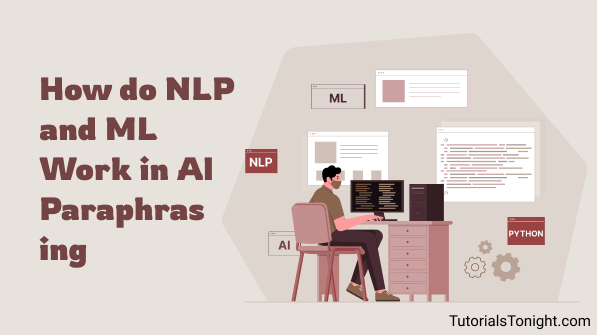How do NLP and ML Work in AI Paraphrasing?
Natural language processing (NLP) is a branch of artificial intelligence that deals with the understanding of different languages. NLP is enabling machines to read and interpret linguistics humanely. Through NLP, machines like Chabot, IOT devices, paraphrasing tools, rewriting tools, home automation machines, etc are helping humans in matchless ways.
On the other side of the paper, Machine learning (ML) is a part of artificial intelligence that helps in gathering and matching patterns to predict the output. Machine learning is a field that is trying to help machines to think and take actions like humans. Moreover, it is about training the machines to learn from the data given to them and the outputs they are producing.

In this article, we will see how NLP and ML work together in AI paraphrasing. AI paraphrasing is performed by paraphrasing tools built on the principles of AI, NLP, and ML. They are different from normal paraphrasing tools as they interpret the content like humans do and they keep on learning the making their output better day after day.
What is NLP and ML in AI Paraphrasing?
Natural Language Processing
NLP deals with analyzing and manipulating the content given to a paraphrasing tool. It breaks down the content in its simplest form. The processes involved in NLP are mentioned as follows:
- Sentiment Analysis: In this step, the NLP analyzes the tone of the content.
- Stemming: The Process of chopping off a word to its stem without considering the dictionary meaning.
- Lemmatization: The process of lemmatizing the words from the end with considering their dictionary meaning.
- Bag of Words: Bag or words or stop word removal is the removal of some words that do not affect the context of the content.
- Term Frequency-Inverse Document Frequency: It is for determining the number of times a keyword occurs in a piece of content. It is measured by the number of times a keyword occurs in a document divided by the total number of words in that document.
After passing the content provided to the AI paraphrasing tool, it turns it into its simplest form. Through stemming and lemmatization, the words in a piece of content are converted into the shortest format.
While with bag words or stop words removal, the unnecessary and repeatedly occurring words are removed.
Therefore, it is undoubtedly clear that NLP has a big hand in the working of an AI paraphrasing tool. Let us now explain the working of machine learning in AI paraphrasing.
Machine Learning
Machine learning is the process of training machines or tools with data. They get better day after day due to processing an excessive amount of data. Machine learning enables the tools to learn from the process and try to produce a better version of output every time.
Machine learning has made the process of paraphrasing smooth. An AI paraphrasing tool uses machine learning to reword the content fast. It works closely with NLP to further enhance the paraphrasing process. It is more competent and efficient due to fewer limitations.
NLP help in understanding the content whereas machine learning help in manipulating the words and sentences in it. Machine learning also helps in predicting text and paraphrasing content in different languages.
How ML and NLP Help AI Paraphrasing Tools
There are a few perks of using ML and NLP in AI paraphrasing tools are mentioned below.

-
Help Providing Unique Content
A paraphrasing tool can help in writing plagiarism-free content. Moreover, it can also be used to make a plagiarized piece of content unique. If you like a sentence or paragraph that was written somewhere and you want to use it in your content, you can simply rephrase it to get rid of plagiarism and use it in your content.
An AI-based paraphrasing tool uses ML and NLP to change the words in a plagiarized text with their most appropriate synonyms. Moreover, it manipulates the structure of content to remove redundant words and chops off the unnecessary parts from the sentences.
-
Help Make the Content Readable
If you feel like your content is difficult to read or contains words that are rare or not easily understandable to anyone, you can paraphrase it using an AI paraphrasing tool. Google likes content that contains easy vocabulary and words that's why you should always try to use a maximum of easy words and short sentences.
An AI paraphrasing tool can swap the hard words with the easy ones without changing the contextual meaning of the content. Moreover, a few of them also deals with the length of sentences because short sentences are preferred for better readability.
-
Help Reduce the Use of Quotes
Although, using quotes whenever stating someone's saying or writing is very helpful in making your content credible and attractive. But, overusing quotes can decrease the quality of content. That is why you can paraphrase the quotes using AI paraphrasing tools to remove plagiarism. A paraphrasing tool will reword the quotes to make them unique. Afterward, you can use them freely in your content.
Conclusion
Natural language processing and machine learning work in the backend of an AI paraphrasing tool to help make the content unique, plagiarism free, highly readable, and attractive. NLP and ML also works in making the content SEO optimized by finding and targeting the keyword through TF-IDF algorithms of NLP.
